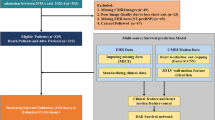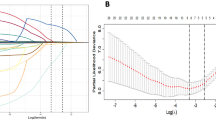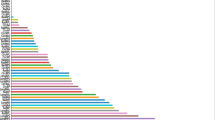Abstract
Background
Studies have shown that the conventional parameters characterizing left ventricular mechanical dyssynchrony (LVMD) measured on gated SPECT myocardial perfusion imaging (MPI) have their own statistical limitations in predicting cardiac resynchronization therapy (CRT) response. The purpose of this study is to discover new predictors from the polarmaps of LVMD by deep learning to help select heart failure patients with a high likelihood of response to CRT.
Methods
One hundred and fifty-seven patients who underwent rest gated SPECT MPI were enrolled in this study. CRT response was defined as an increase in left ventricular ejection fraction (LVEF) > 5% at 6 \(\pm\) 1 month follow up. The autoencoder (AE) technique, an unsupervised deep learning method, was applied to the polarmaps of LVMD to extract new predictors characterizing LVMD. Pearson correlation analysis was used to explain the relationships between new predictors and existing clinical parameters. Patients from the IAEA VISION-CRT trial were used for an external validation. Heatmaps were used to interpret the AE-extracted feature.
Results
Complete data were obtained in 130 patients, and 68.5% of them were classified as CRT responders. After variable selection by feature importance ranking and correlation analysis, one AE-extracted LVMD predictor was included in the statistical analysis. This new AE-extracted LVMD predictor showed statistical significance in the univariate (OR 2.00, P = .026) and multivariate (OR 1.11, P = .021) analyses, respectively. Moreover, the new AE-extracted LVMD predictor not only had incremental value over PBW and significant clinical variables, including QRS duration and left ventricular end-systolic volume (AUC 0.74 vs 0.72, LH 7.33, P = .007), but also showed encouraging predictive value in the 165 patients from the IAEA VISION-CRT trial (P < .1). The heatmaps for calculation of the AE-extracted predictor showed higher weights on the anterior, lateral, and inferior myocardial walls, which are recommended as LV pacing sites in clinical practice.
Conclusions
AE techniques have significant value in the discovery of new clinical predictors. The new AE-extracted LVMD predictor extracted from the baseline gated SPECT MPI has the potential to improve the prediction of CRT response.





Similar content being viewed by others
Abbreviations
- AE:
-
Autoencoder
- CRT:
-
Cardiac resynchronization therapy
- LVEDV:
-
Left ventricular end diastolic volume
- LVEF:
-
Left ventricular ejection fraction
- LVESV:
-
Left ventricular end systolic volume
- LVMD:
-
Left ventricular mechanical dyssynchrony
- MPI:
-
Myocardial perfusion imaging
- PSD:
-
Phase histogram standard deviation
- PBW:
-
Phase histogram bandwidth
- SPECT:
-
Single-photon emission computed tomography
References
Tracy CM, Epstein AE, Darbar D, DiMarco JP, Dunbar SB, Estes NAM. 2012 ACCF/AHA/HRS focused update incorporated into the ACCF/AHA/HRS 2008 guidelines for device-based therapy of cardiac rhythm abnormalities: A report of the American College of Cardiology Foundation/American Heart Association Task Force on Practice Guidelines and the Heart Rhythm Society. J Am Coll Cardiol 2013;61:e6‐75.
Ponikowski P, Voors AA, Anker SD, Bueno H, Cleland JGF, Coats AJS, et al. 2016 ESC Guidelines for the diagnosis and treatment of acute and chronic heart failure. Eur Heart J 2016;37:2129‐2200m.
Zhou W, Garcia EV. Nuclear image-guided approaches for cardiac resynchronization therapy (CRT). Curr Cardiol Rep 2016;18:7.
He Z, Garcia EV, Zhou W. Nuclear imaging guiding cardiac resynchronization therapy. In: Nuclear cardiology: Basic and advanced concepts in clinical practice. Berlin: Springer; 2021.
Chung ES, Leon AR, Tavazzi L, Sun JP, Nihoyannopoulos P, Merlino J, et al. Results of the predictors of response to CRT (PROSPECT) trial. Circulation 2008;117:2608‐16.
Azizian N, Rastgou F, Ghaedian T, Golabchi A, Bahadorian B, Khanlarzadeh V, et al. LV dyssynchrony assessed with phase analysis on gated myocardial perfusion spect can predict response to CRT in patients with end-stage heart failure. Res Cardiovasc Med 2014;3:6.
Mukherjee A, Patel CD, Naik N, Sharma G, Roy A. Quantitative assessment of cardiac mechanical dyssynchrony and prediction of response to cardiac resynchronization therapy in patients with nonischaemic dilated cardiomyopathy using gated myocardial perfusion SPECT. Nucl Med Commun 2015. https://doi.org/10.1097/MNM.0000000000000282.
Friehling M, Chen J, Saba S, Bazaz R, Schwartzman D, Adelstein EC, et al. A prospective pilot study to evaluate the relationship between acute change in left ventricular synchrony after cardiac resynchronization therapy and patient outcome using a single-injection gated SPECT protocol. Circ Cardiovasc Imaging 2011;4:532‐9.
Tsai SC, Chang YC, Chiang KF, Lin WY, Huang JL, Hung GU, et al. LV dyssynchrony is helpful in predicting ventricular arrhythmia in ischemic cardiomyopathy after cardiac resynchronization therapy a preliminary study. Med U S 2016;95:e2840.
Henneman MM, Chen J, Dibbets-Schneider P, Stokkel MP, Bleeker GB, Ypenburg C, et al. Can LV dyssynchrony as assessed with phase analysis on gated myocardial perfusion SPECT preferably predict response to CRT? J Nucl Med 2007;48:1104‐11.
O’Connell JW, Schreck C, Moles M, Badwar N, DeMarco T, Olgin J, et al. A unique method by which to quantitate synchrony with equilibrium radionuclide angiography. J Nucl Cardiol 2005;12:441‐50.
Van Kriekinge SD, Nishina H, Ohba M, Berman DS, Germano G. Automatic global and regional phase analysis from gated myocardial perfusion SPECT imaging: Application to the characterization of ventricular contraction in patients with left bundle branch block. J Nucl Med 2008;49:1790‐7.
Nakajima K, Okuda K, Matsuo S, Kiso K, Kinuya S, Garcia EV. Comparison of phase dyssynchrony analysis using gated myocardial perfusion imaging with four software programs: Based on the Japanese Society of Nuclear Medicine working group normal database. J Nucl Cardiol 2017;24:611‐21.
Peix A, Karthikeyan G, Massardo T, Kalaivani M, Patel C, Pabon LM, et al. Value of intraventricular dyssynchrony assessment by gated-SPECT myocardial perfusion imaging in the management of heart failure patients undergoing cardiac resynchronization therapy (VISION-CRT). J Nucl Cardiol 2019. https://doi.org/10.1007/s12350-018-01589-5.
Gendre R, Lairez O, Mondoly P, Duparc A, Carrié D, Galinier M, et al. Research of predictive factors for cardiac resynchronization therapy: a prospective study comparing data from phase-analysis of gated myocardial perfusion single-photon computed tomography and echocardiography: Trying to anticipate response to CRT. Ann Nucl Med 2017;31:218‐26.
Zhang X, Qian Z, Tang H, Hua W, Su Y, Xu G, et al. A new method to recommend left ventricular lead positions for improved CRT volumetric response and long-term prognosis. J Nucl Cardiol 2019;28:372‐84.
Tajik AJ. Machine learning for echocardiographic imaging: Embarking on another incredible journey. J Am Coll Cardiol 2016;68:2296‐8.
Bengio Y, Courville A, Vincent P. Representation learning: A review and new perspectives. IEEE Trans Pattern Anal Mach Intell 2013;35:1798‐828.
Betancur J, Rubeaux M, Fuchs TA, Otaki Y, Arnson Y, Slipczuk L, et al. Automatic valve plane localization in myocardial perfusion SPECT/CT by machine learning: Anatomic and clinical validation. J Nucl Med 2017;58:961‐7.
Lecun Y, Bengio Y, Hinton G. Deep learning. Nature 2015;521:436‐44.
Esteva A, Kuprel B, Novoa RA, Ko J, Swetter SM, Blau HM, et al. Dermatologist-level classification of skin cancer with deep neural networks. Nature 2017;542:115‐8.
Betancur J, Commandeur F, Motlagh M, Sharir T, Einstein AJ, Bokhari S, et al. Deep learning for prediction of obstructive disease from fast myocardial perfusion SPECT. A Multicenter Study. JACC Cardiovasc Imaging 2018;11:1654‐63.
Xu Y, Mo T, Feng Q, Zhong P, Lai M, Chang EI. Deep learning of feature representation with multiple instance learning for medical image analysis. State Key Laboratory of Software Development Environment , Key Laboratory of Biomechanics and Mechanobiology of Ministry of Education , Beihang University M. IEEE Int Conf Acoust Speech Signal Process 2014; 1645–49.
Bleeker GB, Bax JJ, Fung JW-H, van der Wall EE, Zhang Q, Schalij MJ, et al. Clinical versus echocardiographic parameters to assess response to cardiac resynchronization therapy. Am J Cardiol 2006;97:260‐3.
Bax JJ, Marwick TH, Molhoek SG, Bleeker GB, van Erven L, Boersma E, et al. Left ventricular dyssynchrony predicts benefit of cardiac resynchronization therapy in patients with end-stage heart failure before pacemaker implantation. Am J Cardiol 2003;92:1238‐40.
Henzlova MJ, Duvall WL, Einstein AJ, Travin MI, Verberne HJ. ASNC imaging guidelines for SPECT nuclear cardiology procedures: Stress, protocols, and tracers. J Nucl Cardiol 2016;23:606‐39.
Chen J, Kalogeropoulos AP, Verdes L, Butler J, Garcia EV. Left-ventricular systolic and diastolic dyssynchrony as assessed by multi-harmonic phase analysis of gated SPECT myocardial perfusion imaging in patients with end-stage renal disease and normal LVEF. J Nucl Cardiol 2011;18:299‐308.
Chen J, Garcia EV, Folks RD, Cooke CD, Faber TL, Tauxe EL, et al. Onset of left ventricular mechanical contraction as determined by phase analysis of ECG-gated myocardial perfusion SPECT imaging: Development of a diagnostic tool for assessment of cardiac mechanical dyssynchrony. J Nucl Cardiol 2005;12:687‐95.
Goodfellow I, Bengio Y, Courville A. Autoencoders. In: Deep Learning. Cambridge: MIT Press; 2016.
Goodfellow I, Yoshua B, Courville A. Deep learning. Cambridge: MIT Press; 2016.
Zhang Y, Chen W, Yeo CK, Lau CT, Lee BS. Detecting rumors on Online Social Networks using multi-layer autoencoder. In: 2017 IEEE Technology & Engineering Management Conference (TEMSCON). Santa Clara: IEEE; 2017. p. 437‐41.
Paszke A, Gross S, Chintala S, Chanan G, Yang E, DeVito Z, et al. Automatic differentiation in PyTorch; 2017
Seabold S, Perktold J. Statsmodels: Econometric and statistical modeling with python. Proc 9th Python Sci Conf 2010; p. 92–96.
Jimenez-Heffernan A, Butt S, Mesquita CT, Massardo T, Peix A, Kumar A, et al. Technical aspects of gated SPECT MPI assessment of left ventricular dyssynchrony used in the VISION-CRT study. J Nucl Cardiol 2020. https://doi.org/10.1007/s12350-020-02122-3.
He Z, de Amorim Fernandes F, do Nascimento EA, Garcia EV, Mesquita CT, Zhou W. Incremental value of left ventricular shape parameters measured by gated SPECT MPI in predicting the super-response to CRT. J Nucl Cardiol 2021. https://doi.org/10.1007/s12350-020-02469-7.
Nakamura K, Takami M, Shimabukuro M, Maesato A, Chinen I, Ishigaki S, et al. Effective prediction of response to cardiac resynchronization therapy using a novel program of gated myocardial perfusion single photon emission computed tomography. Europace 2011;13:1731‐7.
Tao N, Qiu Y, Tang H, Qian Z, Wu H, Zhu R, et al. Assessment of left ventricular contraction patterns using gated SPECT MPI to predict cardiac resynchronization therapy response. J Nucl Cardiol 2018;25:2029‐38.
Zhou W, Hung G-U. Left-ventricular mechanical dyssynchrony in the prognosis of dilated cardiomyopathy: Which parameter is more useful? J Nucl Cardiol 2018;25:1688‐91.
Spicker P. The real dependent variable problem: The limitations of quantitative analysis in comparative policy studies. Soc Policy Adm 2018;52:216‐28.
Chen M, Shi X, Zhang Y, Wu D, Guizani M. Deep features learning for medical image analysis with convolutional autoencoder neural network. IEEE Trans Big Data 2017;7790:1‐1.
Cikes M, Sanchez-Martinez S, Claggett B, Duchateau N, Piella G, Butakoff C, et al. Machine learning-based phenogrou** in heart failure to identify responders to cardiac resynchronization therapy. Eur J Heart Fail 2019;21:74‐85.
Petch J, Di S, Nelson W. Opening the black box: The promise and limitations of explainable machine learning in cardiology. Can J Cardiol 2022;38:204‐13.
Guidi JL, Clark K, Upton MT, Faust H, Umscheid CA, Lane-Fall MB, et al. Clinician perception of the effectiveness of an automated early warning and response system for sepsis in an Academic Medical Center. Ann Am Thorac Soc 2015;12:1514‐9.
Becker M, Altiok E, Ocklenburg C, Krings R, Adams D, Lysansky M, et al. Analysis of LV lead position in cardiac resynchronization therapy using different imaging modalities. JACC Cardiovasc Imaging 2010;3:472‐81.
Zhou W, Hou X, Piccinelli M, Tang X, Tang L, Cao K, et al. 3D fusion of LV venous anatomy on fluoroscopy venograms with epicardial surface on SPECT myocardial perfusion images for guiding CRT LV lead placement. JACC Cardiovasc Imaging 2014;7:1239‐48.
Singh JP, Klein HU, Huang DT, Reek S, Kuniss M, Quesada A, et al. Left ventricular lead position and clinical outcome in the multicenter automatic defibrillator implantation trial-cardiac resynchronization therapy (MADIT-CRT) trial. Circulation 2011;123:1159‐66.
Mizunobu M, Sakai J, Sasao H, Murai H, Fujiwara H. Assessment of left ventricular systolic and diastolic function using ECG-gated technetium-99m tetrofosmin myocardial perfusion SPECT: Comparison with ultrasound echocardiography. Int Heart J 2013;54:212‐5.
Garg N, Dresser T, Aggarwal K, Gupta V, Mittal MK, Alpert MA. Comparison of left ventricular ejection fraction values obtained using invasive contrast left ventriculography, two-dimensional echocardiography, and gated single-photon emission computed tomography. SAGE Open Med 2016;4:205031211665594.
Gimelli A, Landi P, Marraccini P, Sicari R, Frumento P, L’Abbate A, et al. Left ventricular ejection fraction measurements: accuracy and prognostic implications in a large population of patients with known or suspected ischemic heart disease. Int J Cardiovasc Imaging 2008;24:793‐801.
Shojaeifard M, Ghaedian T, Yaghoobi N, Malek H, Firoozabadi H, Bitarafan-Rajabi A, et al. Comparison of gated SPECT myocardial perfusion imaging with echocardiography for the measurement of left ventricular volumes and ejection fraction in patients with severe heart failure. Res Cardiovasc Med 2015. https://doi.org/10.5812/cardiovascmed.29005.
Acknowledgments
This research was supported by a grant from the American Heart Association (Project Number: 17AIREA33700016, PI: Weihua Zhou), a new faculty grant from Michigan Technological University Institute of Computing and Cybersystems (PI: Weihua Zhou), a Michigan Technological Research Excellence Fund Research Seed grant (PI: Weihua Zhou), and a grant from the National Nature Science Foundation of China (Project Number: 82070521, PI: Jiangang Zou). The authors would like to thank the International Atomic Energy Agency (IAEA) for providing access to the data of the multicenter trial: “Value of intraventricular synchronism assessment by gated-SPECT myocardial perfusion imaging in the management of heart failure patients submitted to cardiac resynchronization therapy” (IAEA VISION-CRT), Coordinated Research Protocol E1.30.34.
Author information
Authors and Affiliations
Contributions
ZH: Conception design, and analysis and interpretation of data; drafting of the manuscript and revising it critically for important intellectual content; and final approval of the manuscript submitted. XZ: Active involvement in collecting data and performing experiments with subsequent participation in data analysis, drafting the manuscript, and revising it critically for important intellectual content. CZ: Conception design, and analysis and interpretation of data. XL: Conception design, and analysis and interpretation of data. SM: Analysis and interpretation of data. ZQ: Active involvement in collecting data and performing experiments with subsequent participation in data analysis. YW: Active involvement in collecting data and performing experiments with subsequent participation in data analysis. XH: Active involvement in collecting data and performing experiments with subsequent participation in data analysis. JZ: Active involvement in collecting data and performing experiments with subsequent participation in data analysis; and final approval of the manuscript submitted. WZ: Conception design, and analysis and interpretation of data; drafting of the manuscript and revising it critically for important intellectual content; and final approval of the manuscript submitted.
Corresponding authors
Ethics declarations
Disclosures
All authors declare that there are no conflict of interest.
Additional information
Publisher's Note
Springer Nature remains neutral with regard to jurisdictional claims in published maps and institutional affiliations.
The authors of this article have provided a PowerPoint file, available for download at SpringerLink, which summarises the contents of the paper and is free for re-use at meetings and presentations. Search for the article DOI on SpringerLink.com.
The authors have also provided an audio summary of the article, which is available to download as ESM, or to listen to via the JNC/ASNC Podcast.
Supplementary Information
Below is the link to the electronic supplementary material.
Rights and permissions
About this article
Cite this article
He, Z., Zhang, X., Zhao, C. et al. A method using deep learning to discover new predictors from left-ventricular mechanical dyssynchrony for CRT response. J. Nucl. Cardiol. 30, 201–213 (2023). https://doi.org/10.1007/s12350-022-03067-5
Received:
Accepted:
Published:
Issue Date:
DOI: https://doi.org/10.1007/s12350-022-03067-5




